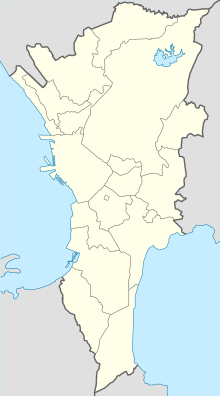University of Santo Tomas Field
| University of Santo Tomas Athletic Field and Open Spaces | |
|---|---|
| Native name Hayag na Dako ng Pangunahing Istadyum[1] (Filipino) | |
 | |
| Location | University of Santo Tomas, Manila, Philippines |
| Coordinates | 14°36′30.4″N 120°59′21.8″E / 14.608444°N 120.989389°E |
| Designated | January 25, 2010 |
| Reference no. | 1–2010[2] |
The University of Santo Tomas Athletic Field and Open Spaces, located at the University of Santo Tomas in Manila, is a National Cultural Treasure as declared by the National Museum of the Philippines.[3][4][5][6][7][8]
History
[edit]The campus grounds are noteworthy for various events such as the internment of American and other nationals during World War II, the Battle of Manila, and the four papal visits. The grounds have been transformed from the original swamp with a creek crossing over it to a well-kept green field that has become the single biggest open green area in Manila.[6] It was significant because three pontiffs made appearance here, Pope Paul VI in 1970, Pope John Paul II in 1981 and 1995 and Pope Francis in 2015.
Official declaration
[edit]Section 3 of “The Cultural Properties Preservation and Protection Act” states that a “National Cultural Treasure is a unique object found locally, possessing outstanding historical, cultural, artistic and/or scientific value which is significant and important to this country and nation.” This prestigious recognition marks the first ever inclusion of an educational institution among the ranks of National Cultural Treasures, with the majority of structures being churches and the rest being terrestrial landmarks, intangible cultural property and movable objects." As heritage sites, they will be accorded protection and recognition, giving importance to their witness of 400 years of tumultuous Philippine history.[3][5]
References
[edit]- ^ Untitled (Plaque inside building) (in English and Filipino). UST Main Building, near the front entrance of the UST Museum of Arts and Sciences: National Museum of the Philippines. 25 January 2010.
- ^ "National Museum of the Philippines Annual Report 2010" (PDF). National Museum of the Philippines. 2011. Retrieved June 13, 2020.
- ^ a b National Museum declares UST structures as National Cultural TreasuresUniversity of Santo Tomas website accessed October 27, 2012
- ^ Formal Declaration of UST National Cultural Treasures Archived 2013-07-28 at the Wayback MachineUniversity of Santo Tomas Museum of Arts and Sciences website accessed October 27, 2012
- ^ a b UST sites declared 'National Treasures'The Varsitarian website accessed October 27, 2012
- ^ a b UST landmarks declared ‘National Treasures’The Inquirer website accessed October 27, 2012
- ^ UST landmarks to be declared national cultural treasuresThe Manila Bulletin website accessed October 27, 2012
- ^ UST spots declared cultural treasuresGMA Network website accessed October 27, 2012



